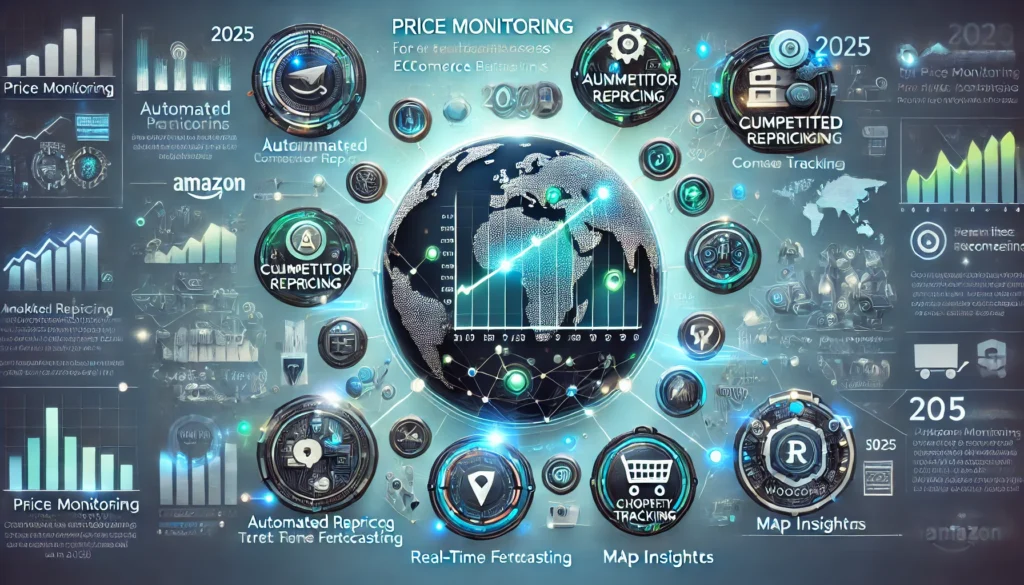Introduction: Why Price Monitoring is No Longer Optional
In today’s hyper-competitive eCommerce landscape, staying ahead requires more than intuition—it demands real-time insights. Price monitoring services have emerged as a cornerstone for businesses aiming to optimize pricing strategies, forecast demand, and outmaneuver competitors. Whether you’re a small online retailer or a multinational brand, these tools automate market analysis, freeing your team from manual data crunching while delivering actionable intelligence 25.
This guide explores five leading price monitoring platforms, their unique features, and how they can transform your business. Let’s dive in.
Table of Contents
Why Price Monitoring Matters: Beyond Competitive Edge
Price monitoring isn’t just about tracking numbers—it’s about strategic agility. Here’s why it’s critical in 2025:
- Dynamic Market Adaptation: With prices fluctuating hourly on platforms like Amazon and Shopify, automated tools provide real-time updates to keep your pricing competitive 5.
- Demand Forecasting: Historical data analysis helps predict trends, allowing businesses to adjust inventory and promotions proactively 10.
- Brand Protection: Monitoring ensures compliance with Minimum Advertised Price (MAP) policies, safeguarding brand integrity 2.
- Cost Efficiency: Automating price tracking reduces labor costs and human error, letting teams focus on growth 5.
Top 5 Price Monitoring Services in 2025
1. Price Control: Precision for Brands and Retailers
Region: Ukraine, Europe, Asia | Pricing: Starts at $119/month
Best For: Brands prioritizing legal compliance and regional insights.
Key Features:
- MAP Monitoring: Ensures retailers adhere to pricing policies.
- Competitor Tracking: Analyzes prices across 100+ marketplaces.
- Legal Safeguards: Offers intellectual property protection and dispute resolution support.
Why It Stands Out:
Price Control combines affordability with robust functionality, including automated link matching and anti-parsing software. Clients praise its 99.8% data accuracy and responsive customer service. However, smaller retailers may find the cost prohibitive 210.
2. Competera: Enterprise-Level Pricing Intelligence
Region: Global | Pricing: Custom (starts around $750/month)
Best For: Large retailers needing predictive analytics.
Key Features:
- AI-Driven Predictions: Forecasts market trends using historical data.
- Rule-Based Pricing: Adjusts prices based on competitor moves and inventory levels.
- Omnichannel Insights: Tracks prices across websites, apps, and physical stores.
Why It Stands Out:
Competera’s strength lies in its adaptability to complex pricing strategies. Users highlight its tailored solutions, though its enterprise-tier pricing excludes smaller businesses 10.
3. Price2Spy: Affordable Automation for Global Retailers
Region: Global | Pricing: Starts at $26.95/month
Best For: Manufacturers and mid-sized eCommerce platforms.
Key Features:
- Profitability Analysis: Identifies margin opportunities across product lines.
- MAP Compliance Alerts: Flags violations in real time.
- Flexible Pricing Models: Choose between automated or manual repricing.
Why It Stands Out:
Price2Spy balances cost and functionality, earning praise for its user-friendly interface. However, add-ons like link matching incur extra fees, which can inflate costs 10.
4. Prisync: Simplified Dynamic Pricing for SMEs
Region: Global | Pricing: Starts at $99/month
Best For: Small to medium retailers on Shopify or WooCommerce.
Key Features:
- Competitor Benchmarking: Tracks prices across 50+ platforms.
- Dynamic Pricing Rules: Adjusts prices based on competitor data and inventory.
- Google Shopping Integration: Syncs product listings for seamless updates.
Why It Stands Out:
Prisync excels in ease of use and integration with popular eCommerce tools. However, its reliance on automated link matching can lead to occasional errors, and it lacks anti-parsing tools 10.
5. Wiser Solutions: AI-Powered Market Dominance
Region: Global | Pricing: Custom
Best For: Enterprises investing in machine learning and trend analysis.
Key Features:
- Consumer Behavior Insights: Analyzes buying patterns to optimize pricing.
- Brand Reputation Management: Monitors unauthorized sellers and counterfeit listings.
- Custom Dashboards: Tailors reports to C-suite and operational teams.
Why It Stands Out:
Wiser’s machine learning algorithms offer unparalleled accuracy in trend prediction. However, its lack of transparent pricing makes it inaccessible to smaller businesses 10.
Choosing the Right Service: 5 Key Considerations
- Scalability: Ensure the tool grows with your business. For example, Price Control suits expanding brands, while Competera fits established enterprises 210.
- Integration: Look for compatibility with your existing tech stack. Prisync’s Shopify integration simplifies workflows for online stores 10.
- Data Accuracy: Opt for services like Price Control, which boasts 99.8% precision, to avoid costly errors 2.
- Support: Responsive customer service, as highlighted by Price2Spy users, is crucial for troubleshooting 10.
- Cost vs. ROI: Balance upfront costs with long-term gains. For SMEs, Price2Spy offers a budget-friendly entry point 10.
Conclusion: Future-Proof Your Pricing Strategy
The right price monitoring service isn’t a luxury—it’s a necessity in 2025’s volatile markets. Whether you choose Price Control for its regional expertise or Wiser for AI-driven insights, automation will streamline operations and boost profitability.


2 Comments
Hey would you mind letting me know which hosting company you’re working with?
I’ve loaded your blog in 3 completely different web browsers and I must say this blog loads a lot faster then most.
Can you recommend a good hosting provider at a fair price?
Thanks, I appreciate it!
Great goods from you,man. I have understand your stuff previous
to and you are just too magnificent. I actually like what you have acquired here,
certainly like what you are stating and the way in which you say it.
You make it enjoyable and you still take care
of to keep it smart. I can’t wait to read much more from you.
This is really a great site.